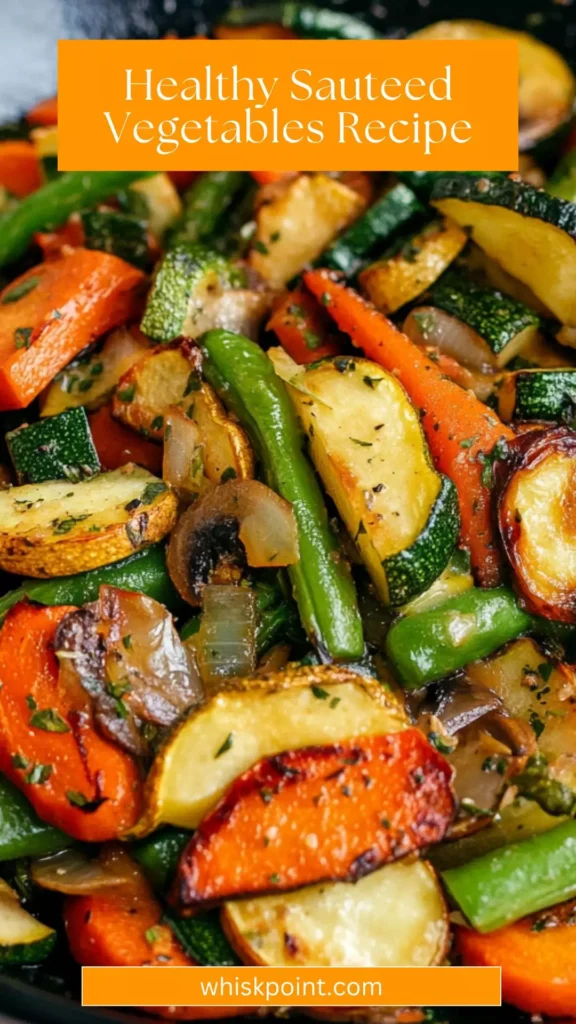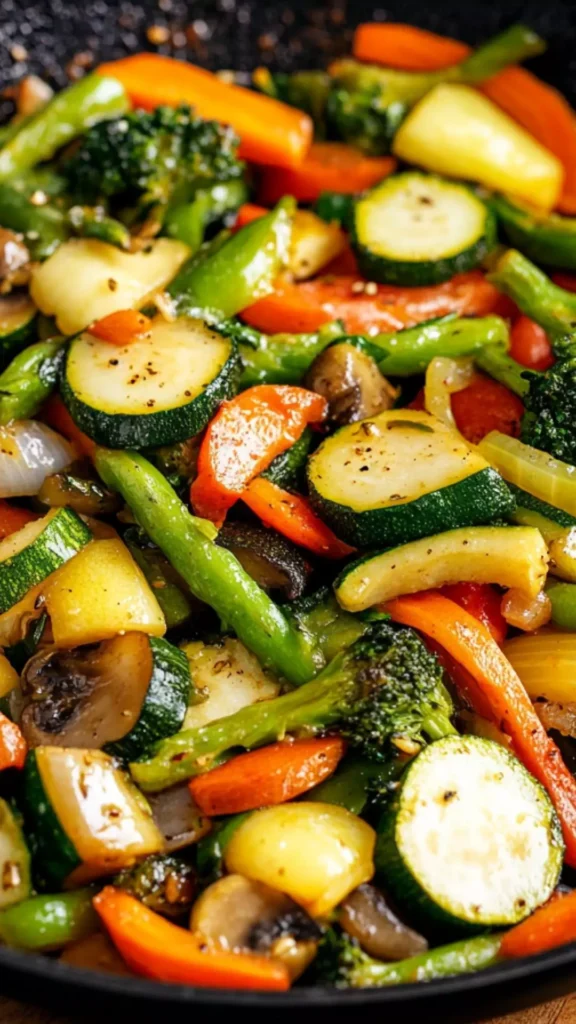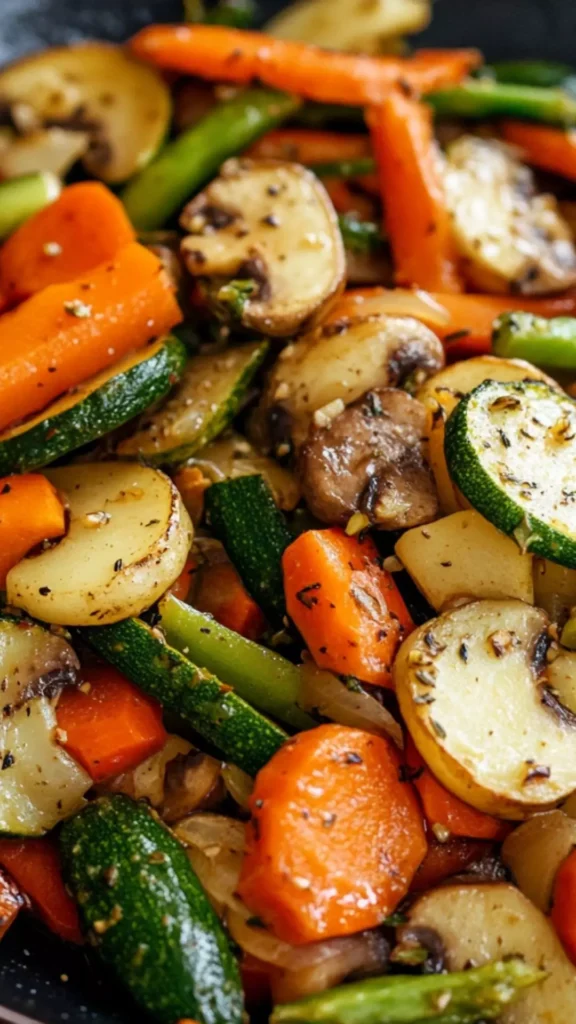Before diving into the delightful world of sautéed vegetables, let’s consider what pairs beautifully. The great thing about sautéed veggies is their versatility. You could serve them alongside grilled chicken, baked salmon, or even quinoa for a fulfilling vegetarian option.
They complement whole grains like brown rice or farro especially well, offering a balance of flavors and textures. You might also consider pairing these vibrant veggies with a tangy yogurt sauce or sprinkling some toasted nuts for an added crunch.
Trust me, your dinner plate is about to become a colorful, nutritious canvas.

We all love that quick and easy dish that can brighten up our meals while being healthy. That’s where sautéed vegetables come in.
I remember the first time I attempted this dish in my kitchen—steam rising, that lovely crackle of veggies meeting hot oil, and the aroma wafting through my home like a culinary hug.
It struck me then how simple ingredients could yield such vibrant results. Not only is it a visual delight, but it’s also a nutritional power-up.
Here, I’ll walk you through the hows and whys of creating mouthwatering sautéed vegetables, ensuring you leave with not only a recipe but also a wealth of knowledge along the way.
Why This Recipe Works
Let’s break down the reasons this sautéed vegetable recipe is a winner.
1. Nutrient Retention
Sautéing vegetables at high heat for a short amount of time preserves their vitamins and minerals. According to research published in the Journal of Agricultural and Food Chemistry, quick cooking methods like sautéing help keep more of those essential nutrients intact compared to boiling.
2. Flavor Explosion
The high-heat technique caramelizes the natural sugars in your vegetables, enhancing their flavors. Ever notice how a rainbow of colors looks appetizing? Well, it tastes good too! The Maillard reaction occurs here, creating complex flavors that raw veggies can’t compete with.
3. Flexibility with Ingredients
This recipe is incredibly adaptable. Whether you fancy carrots, zucchini, or mushrooms, feel free to toss in whatever you have on hand. You can personalize the dish based on the seasons or your pantry’s inventory.
4. Fast Cooking Time
Who has time for slow dinners? Sautéing can be done in under 15 minutes, which makes it a perfect choice for busy weeknights. As a registered dietitian, I always aim to craft recipes that save time without sacrificing flavor or nutrition.
How Does It Taste?
Imagine biting into perfectly tender asparagus, sweet bell peppers, and a hint of garlic dancing on your taste buds while a sprinkle of Parmesan cheese introduces a delightful umami essence. Each ingredient shines through while harmonizing with the others.
This sautéed veggie dish is savory yet refreshing—ideal for filling the gaps on a dinner plate or standing alone as a light main.
What Sets This Recipe Apart from Other Healthy Sautéed Vegetable Variations?
This recipe isn’t your average sautéed vegetable mix. Where many recipes just throw together whatever is in the fridge, this one focuses on balancing flavors and textures.
The inclusion of fresh herbs, lemon juice, and a smoky blend of spices creates a layered taste experience that’s often missing in simpler preparations. It’s these small, intentional details that lift this dish from basic to extraordinary.
The Ingredients
Gather these key players for your culinary masterpiece:
- 3 cloves of garlic, finely chopped
- 1 cup of thinly sliced carrot rounds
- 1 pound of asparagus spears, woody ends removed, and cut into 1-inch segments
- 1 red bell pepper, thinly sliced into strips
- 1 medium zucchini, cut into thin rounds
- 8 ounces of fresh mushrooms, cleaned and sliced
- 3 green onions, thinly sliced (both green and white parts)
- 2 tablespoons extra-virgin olive oil
- 1/4 cup grated Parmesan cheese
- 1 tablespoon fresh lemon juice
- 1 teaspoon of sea salt
- 1/2 teaspoon of powdered onion
- 1/4 teaspoon of freshly ground black pepper
- A pinch of crushed red pepper flakes
- 1/2 teaspoon of dried Italian herb blend
- 1/4 teaspoon of smoked paprika

Instructions
Let’s roll up those sleeves and get into the nitty-gritty of cooking.
Step 1: Prepare Your Ingredients
Make sure all your vegetables are washed, dried, and cut according to the specifications. You want them uniform for even cooking. Trust me, this little prep step makes a world of difference.
Step 2: Heat the Oil
In a large skillet, add the olive oil over medium-high heat. Wait until it shimmers. This indicates that it’s hot enough to start sautéing.
Step 3: Garlic First, Please!
Add the chopped garlic and sauté for about 30 seconds, until fragrant. Don’t walk away—it burns fast!
Step 4: Introduce the Carrots
Next, toss in those carrot rounds. They take longer to cook, so I like to add them first. Stir frequently for about 2-3 minutes until they start to soften.
Step 5: Introducing the Asparagus and Zucchini
Add the asparagus spears and zucchini next. Continue to stir for another 3-5 minutes. You’re looking for a vivid green color and a tender-crisp texture.
Step 6: Bell Peppers & Mushrooms
Now, it’s time for the bell pepper strips and mushrooms. Toss them in and stir for 2-3 more minutes. They should become vibrant and tender but not mushy.
Step 7: Season It Up
Sprinkle in that sea salt, cracked black pepper, powdered onion, crushed red pepper flakes, Italian herb blend, and smoked paprika. Stir everything together well, allowing the flavors to meld for about a minute.
Step 8: Finishing Touches
Remove the skillet from heat. Drizzle the lemon juice on top and sprinkle with Parmesan cheese. Give it a gentle toss to incorporate everything just before serving.
Notes
Here are some helpful tips to elevate your dish.
- Season incrementally: Add your salt in stages. This helps control the flavor better.
- Cut sizes matter: Keep your vegetable pieces similar in size for even cooking.
- Don’t crowd the pan: If you’re making a large batch, do this in batches to retain that lovely sautéing effect.
- Use fresh herbs: Fresh herbs at the end provide a burst of flavor that dried ones can’t match.
- Try different oils: Experimenting with different oils like avocado or sesame can change the flavor profile deliciously!

How Do You Store Healthy Sautéed Vegetables?
Let your sautéed veggies cool completely before storing. Place them in an airtight container. They can keep in the fridge for up to 3 days. For longer storage, consider freezing them in portions. Just make sure to reheat before serving—reheat gently so as to not overcook them.
Sides for Healthy Sautéed Vegetables
Here are three delightful sides that pair brilliantly with your sautéed veggies.
1. Quinoa Pilaf
A fluffy quinoa pilaf adds a nutty flavor to the plate and complements the veggies nicely. Toss in some herbs or dried fruits for a gourmet touch.
2. Grilled Chicken Breast
A simply seasoned grilled chicken breast offers protein while allowing the vegetables to shine. The smoky flavor contrasts beautifully with the sweetness of the sautéed mixture.
3. Garlic Parmesan Couscous
The light, airy texture of couscous paired with a little bit of garlic and Parmesan is a dream. These flavors add richness without overshadowing your vibrant veggie dish.
What Alternatives Can You Use for the Ingredients?
Don’t have something on hand? Here are some substitutes.
1. Garlic Powder Instead of Fresh Garlic
If fresh garlic isn’t available, you can use garlic powder. Just remember that it’s more concentrated, so start with half a teaspoon.
2. Broccoli or Cauliflower Instead of Asparagus
Feel like switching it up? Broccoli or cauliflower work remarkably well in this dish, adding their own unique textures.
3. Feta Cheese Instead of Parmesan
For those who prefer a little tang, crumbled feta provides an excellent alternative to Parmesan, lending a Mediterranean twist to the mix.
4. Olive Oil Instead of Canola Oil
If olive oil isn’t in your pantry, canola oil can take its place. While it doesn’t bring the same flavor, it allows for excellent sautéing nonetheless.

Healthy Sauteed Vegetables Recipe
Ingredients
Equipment
Method
- Make sure all your vegetables are washed, dried, and cut according to the specifications. You want them uniform for even cooking. Trust me, this little prep step makes a world of difference.
- In a large skillet, add the olive oil over medium-high heat. Wait until it shimmers. This indicates that it’s hot enough to start sautéing.
- Add the chopped garlic and sauté for about 30 seconds, until fragrant. Don’t walk away—it burns fast!
- Next, toss in those carrot rounds. They take longer to cook, so I like to add them first. Stir frequently for about 2-3 minutes until they start to soften.
- Add the asparagus spears and zucchini next. Continue to stir for another 3-5 minutes. You’re looking for a vivid green color and a tender-crisp texture.
- Now, it’s time for the bell pepper strips and mushrooms. Toss them in and stir for 2-3 more minutes. They should become vibrant and tender but not mushy.
- Sprinkle in that sea salt, cracked black pepper, powdered onion, crushed red pepper flakes, Italian herb blend, and smoked paprika. Stir everything together well, allowing the flavors to meld for about a minute.
- Step 8: Finishing Touches
- Remove the skillet from heat. Drizzle the lemon juice on top and sprinkle with Parmesan cheese. Give it a gentle toss to incorporate everything just before serving.
Nutrition
Tried this recipe?
Let us know how it was!Frequently Asked Questions
Conclusion
Sautéed vegetables offer an endless canvas of flavors and textures that enhance any meal. With simple ingredients and quick preparation, this dish becomes a staple in your kitchen arsenal.
Each bite showcases a medley of nutrients, colors, and aromas, transforming your eating experience. Grab your skillet and give this dish a try—you might just find it becomes a favorite in your household, just like it has in mine. Happy cooking!
